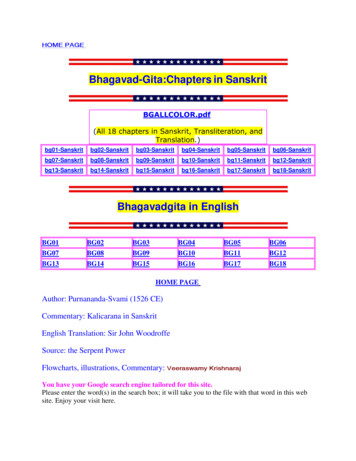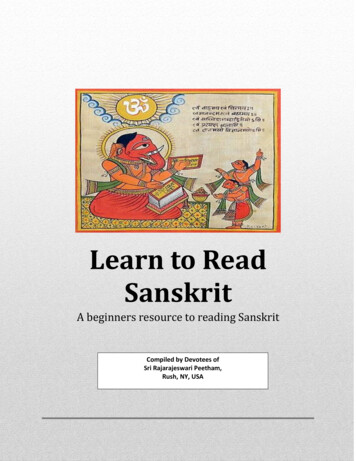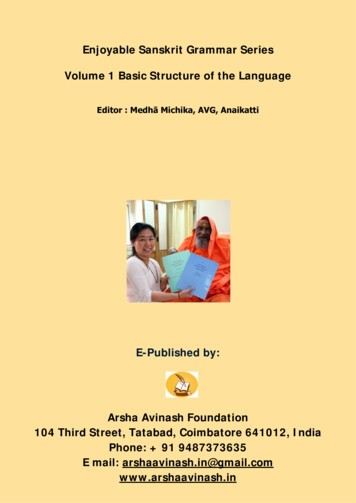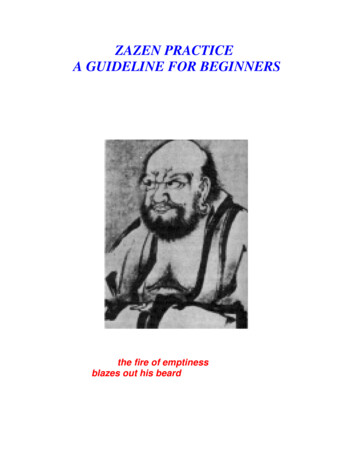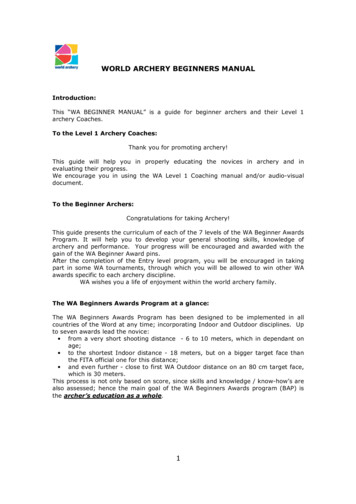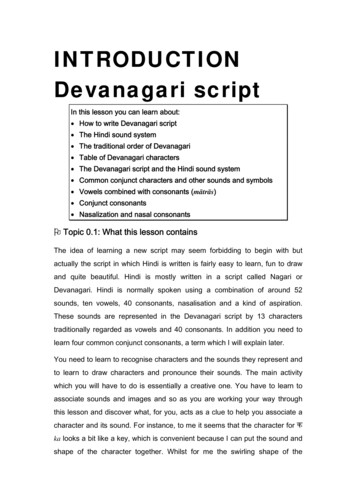
Transcription
Sanskrit for BeginnersA simple and comprehensive guideॐGenerated on 27 February 2022.For the latest version, see https://learnsanskrit.org/guide.
2ContentsPreface to the print edition0123. 6Introduction . . . . . . . . . . . . . . . . . . . . . . . . . . . . . . . . . . . . . . . . . . . . . . . . . 70.1For beginners . . . . . . . . . . . . . . . . . . . . . . . . . . . . . . . . . . . . . . . . . . . 80.2For experts. . . . . . . . . . . . . . . . . . . . . . . . . . . . . . . . . . . . . . . . . . . 13Core lessons . . . . . . . . . . . . . . . . . . . . . . . . . . . . . . . . . . . . . . . . . . . . . . . . 181.1The Sanskrit language . . . . . . . . . . . . . . . . . . . . . . . . . . . . . . . . . . . 191.2Basic vowels . . . . . . . . . . . . . . . . . . . . . . . . . . . . . . . . . . . . . . . . . . 211.3Short and long vowels . . . . . . . . . . . . . . . . . . . . . . . . . . . . . . . . . . . 251.4Semivowels . . . . . . . . . . . . . . . . . . . . . . . . . . . . . . . . . . . . . . . . . . . 291.5Compound vowels . . . . . . . . . . . . . . . . . . . . . . . . . . . . . . . . . . . . . . 311.6Consonants . . . . . . . . . . . . . . . . . . . . . . . . . . . . . . . . . . . . . . . . . . . 361.7anusvāra and visarga . . . . . . . . . . . . . . . . . . . . . . . . . . . . . . . . . . . . 431.8Syllables . . . . . . . . . . . . . . . . . . . . . . . . . . . . . . . . . . . . . . . . . . . . . 471.9Sandhi . . . . . . . . . . . . . . . . . . . . . . . . . . . . . . . . . . . . . . . . . . . . . . . 511.10Sentences . . . . . . . . . . . . . . . . . . . . . . . . . . . . . . . . . . . . . . . . . . . . 581.11Nominals . . . . . . . . . . . . . . . . . . . . . . . . . . . . . . . . . . . . . . . . . . . . 621.12Verbs . . . . . . . . . . . . . . . . . . . . . . . . . . . . . . . . . . . . . . . . . . . . . . . 701.13Uninflected words . . . . . . . . . . . . . . . . . . . . . . . . . . . . . . . . . . . . . 781.14Prefixes . . . . . . . . . . . . . . . . . . . . . . . . . . . . . . . . . . . . . . . . . . . . . 821.15Suffixes . . . . . . . . . . . . . . . . . . . . . . . . . . . . . . . . . . . . . . . . . . . . . 861.16Compounds . . . . . . . . . . . . . . . . . . . . . . . . . . . . . . . . . . . . . . . . . . 901.17Review . . . . . . . . . . . . . . . . . . . . . . . . . . . . . . . . . . . . . . . . . . . . . . 93Sounds . . . . . . . . . . . . . . . . . . . . . . . . . . . . . . . . . . . . . . . . . . . . . . . . . . . 1002.1The sound system . . . . . . . . . . . . . . . . . . . . . . . . . . . . . . . . . . . . . 1012.2Vowels . . . . . . . . . . . . . . . . . . . . . . . . . . . . . . . . . . . . . . . . . . . . . . 1022.3Consonants . . . . . . . . . . . . . . . . . . . . . . . . . . . . . . . . . . . . . . . . . . 1072.4Other sounds . . . . . . . . . . . . . . . . . . . . . . . . . . . . . . . . . . . . . . . . . 1112.5Modern pronunciation. . . . . . . . . . . . . . . . . . . . . . . . . . . . . . . . . 113Sandhi . . . . . . . . . . . . . . . . . . . . . . . . . . . . . . . . . . . . . . . . . . . . . . . . . . . 1153.1The sandhi system . . . . . . . . . . . . . . . . . . . . . . . . . . . . . . . . . . . . . 1163.2Vowel sandhi . . . . . . . . . . . . . . . . . . . . . . . . . . . . . . . . . . . . . . . . . 118
345673.3visarga sandhi . . . . . . . . . . . . . . . . . . . . . . . . . . . . . . . . . . . . . . . . 1243.4Consonant sandhi between words . . . . . . . . . . . . . . . . . . . . . . . . . 1303.5Consonant sandhi within a word . . . . . . . . . . . . . . . . . . . . . . . . . . 138Nominals 1: Normal stems . . . . . . . . . . . . . . . . . . . . . . . . . . . . . . . . . . . . 1424.1The nominal system. . . . . . . . . . . . . . . . . . . . . . . . . . . . . . . . . . . 1434.2Basic nominal endings . . . . . . . . . . . . . . . . . . . . . . . . . . . . . . . . . . 1514.3-a stems . . . . . . . . . . . . . . . . . . . . . . . . . . . . . . . . . . . . . . . . . . . . . 1574.4-ā, -ī, and -ū stems . . . . . . . . . . . . . . . . . . . . . . . . . . . . . . . . . . . . . 1614.5-i and -u stems . . . . . . . . . . . . . . . . . . . . . . . . . . . . . . . . . . . . . . . . 1664.6-ṛ stems . . . . . . . . . . . . . . . . . . . . . . . . . . . . . . . . . . . . . . . . . . . . . 1754.7-ai, -o, and -au stems . . . . . . . . . . . . . . . . . . . . . . . . . . . . . . . . . . . 1824.8Consonant stems . . . . . . . . . . . . . . . . . . . . . . . . . . . . . . . . . . . . . . 186Nominals 2: Pronouns and numbers. . . . . . . . . . . . . . . . . . . . . . . . . . . . 2005.1asmad and yuṣmad. . . . . . . . . . . . . . . . . . . . . . . . . . . . . . . . . . . . 2015.2tad, etad, idam, and adas . . . . . . . . . . . . . . . . . . . . . . . . . . . . . . . . 2055.3kim and yad . . . . . . . . . . . . . . . . . . . . . . . . . . . . . . . . . . . . . . . . . . 2135.4Pronominal adjectives . . . . . . . . . . . . . . . . . . . . . . . . . . . . . . . . . . 2215.5Number words . . . . . . . . . . . . . . . . . . . . . . . . . . . . . . . . . . . . . . . . 223Verbs 1: Special tense-moods . . . . . . . . . . . . . . . . . . . . . . . . . . . . . . . . . . 2386.1Special tense-moods . . . . . . . . . . . . . . . . . . . . . . . . . . . . . . . . . . . 2396.2The present tense6.3The command mood . . . . . . . . . . . . . . . . . . . . . . . . . . . . . . . . . . . 2466.4The ordinary past tense . . . . . . . . . . . . . . . . . . . . . . . . . . . . . . . . . 2486.5The potential mood . . . . . . . . . . . . . . . . . . . . . . . . . . . . . . . . . . . . 2516.6ātmanepada . . . . . . . . . . . . . . . . . . . . . . . . . . . . . . . . . . . . . . . . . . 2546.7The bhū, div, tud, and cur classes6.8The su, tan, and krī classes . . . . . . . . . . . . . . . . . . . . . . . . . . . . . . 2666.9The ad and rudh classes. . . . . . . . . . . . . . . . . . . . . . . . . . . . . . . . . . . . . 243. . . . . . . . . . . . . . . . . . . . . . . . . 259. . . . . . . . . . . . . . . . . . . . . . . . . . . . . . . . 2756.10The hu class . . . . . . . . . . . . . . . . . . . . . . . . . . . . . . . . . . . . . . . . . 2866.11karmaṇi and bhāve prayoga . . . . . . . . . . . . . . . . . . . . . . . . . . . . . 291Verbs 2: Other tense-moods . . . . . . . . . . . . . . . . . . . . . . . . . . . . . . . . . . . 2967.1Other tense-moods. . . . . . . . . . . . . . . . . . . . . . . . . . . . . . . . . . . . 2977.2The simple future tense . . . . . . . . . . . . . . . . . . . . . . . . . . . . . . . . . 300
4891011127.3The conditional mood . . . . . . . . . . . . . . . . . . . . . . . . . . . . . . . . . . 3037.4The distant future tense7.5The distant past tense . . . . . . . . . . . . . . . . . . . . . . . . . . . . . . . . . . 3087.6The recent past tense7.7The blessing moodVerbs 3: Derived roots. . . . . . . . . . . . . . . . . . . . . . . . . . . . . . . . 305. . . . . . . . . . . . . . . . . . . . . . . . . . . . . . . . . . 319. . . . . . . . . . . . . . . . . . . . . . . . . . . . . . . . . . . . 322. . . . . . . . . . . . . . . . . . . . . . . . . . . . . . . . . . . . . . . 3258.1Causal roots . . . . . . . . . . . . . . . . . . . . . . . . . . . . . . . . . . . . . . . . . . 3268.2Desiderative roots . . . . . . . . . . . . . . . . . . . . . . . . . . . . . . . . . . . . . 3298.3Nominal roots . . . . . . . . . . . . . . . . . . . . . . . . . . . . . . . . . . . . . . . . 3338.4Intensive roots . . . . . . . . . . . . . . . . . . . . . . . . . . . . . . . . . . . . . . . . 335Uninflected words . . . . . . . . . . . . . . . . . . . . . . . . . . . . . . . . . . . . . . . . . . 3389.1Types of uninflected words . . . . . . . . . . . . . . . . . . . . . . . . . . . . . . 3399.2The upasarga . . . . . . . . . . . . . . . . . . . . . . . . . . . . . . . . . . . . . . . . . 3419.3Other prefixes . . . . . . . . . . . . . . . . . . . . . . . . . . . . . . . . . . . . . . . . 3469.4ca, vā, and others9.5Adverbs . . . . . . . . . . . . . . . . . . . . . . . . . . . . . . . . . . . . . . . . . . . . . 353. . . . . . . . . . . . . . . . . . . . . . . . . . . . . . . . . . . . . 349Suffixes . . . . . . . . . . . . . . . . . . . . . . . . . . . . . . . . . . . . . . . . . . . . . . . . . . 35410.1The suffix system . . . . . . . . . . . . . . . . . . . . . . . . . . . . . . . . . . . . . 35510.2-tvā and -ya . . . . . . . . . . . . . . . . . . . . . . . . . . . . . . . . . . . . . . . . . 35810.3-ta and -tavat . . . . . . . . . . . . . . . . . . . . . . . . . . . . . . . . . . . . . . . . 36310.4-tum . . . . . . . . . . . . . . . . . . . . . . . . . . . . . . . . . . . . . . . . . . . . . . . 36510.5-tavya, -anīya, and -ya . . . . . . . . . . . . . . . . . . . . . . . . . . . . . . . . . 36810.6-at, -āna, and -vas10.7Other root suffixes . . . . . . . . . . . . . . . . . . . . . . . . . . . . . . . . . . . . 37510.8Nominal suffixes . . . . . . . . . . . . . . . . . . . . . . . . . . . . . . . . . . . . . 379Compounds. . . . . . . . . . . . . . . . . . . . . . . . . . . . . . . . . . . . 371. . . . . . . . . . . . . . . . . . . . . . . . . . . . . . . . . . . . . . . . . . . . . . 38311.1The compound system . . . . . . . . . . . . . . . . . . . . . . . . . . . . . . . . . 38411.2The dvandva. . . . . . . . . . . . . . . . . . . . . . . . . . . . . . . . . . . . . . . . 38811.3The tatpuruṣa. . . . . . . . . . . . . . . . . . . . . . . . . . . . . . . . . . . . . . . 39111.4The bahuvrīhi. . . . . . . . . . . . . . . . . . . . . . . . . . . . . . . . . . . . . . . 39411.5The avyayībhāva. . . . . . . . . . . . . . . . . . . . . . . . . . . . . . . . . . . . . 397Sentences . . . . . . . . . . . . . . . . . . . . . . . . . . . . . . . . . . . . . . . . . . . . . . . . 39812.1Sentence structure . . . . . . . . . . . . . . . . . . . . . . . . . . . . . . . . . . . . 399
5131412.2Agreement . . . . . . . . . . . . . . . . . . . . . . . . . . . . . . . . . . . . . . . . . . 40212.3Verbless sentences . . . . . . . . . . . . . . . . . . . . . . . . . . . . . . . . . . . . 40712.4Questions . . . . . . . . . . . . . . . . . . . . . . . . . . . . . . . . . . . . . . . . . . . 40912.5Relative phrases . . . . . . . . . . . . . . . . . . . . . . . . . . . . . . . . . . . . . . 41412.6Participles12.7The eight cases. . . . . . . . . . . . . . . . . . . . . . . . . . . . . . . . . . . . . . 422Devanagari . . . . . . . . . . . . . . . . . . . . . . . . . . . . . . . . . . . . . . . . . . . . . . . 42913.1How Devanagari works . . . . . . . . . . . . . . . . . . . . . . . . . . . . . . . . 43013.2Vowels and consonants . . . . . . . . . . . . . . . . . . . . . . . . . . . . . . . . 43313.3Vowel marks13.4Consonant clusters . . . . . . . . . . . . . . . . . . . . . . . . . . . . . . . . . . . . 43813.5Numerals and punctuation13.6Old Devanagari . . . . . . . . . . . . . . . . . . . . . . . . . . . . . . . . . . . . . . 44413.7Vedic Devanagari . . . . . . . . . . . . . . . . . . . . . . . . . . . . . . . . . . . . . 445. . . . . . . . . . . . . . . . . . . . . . . . . . . . . . . . . . . . . . . . 436. . . . . . . . . . . . . . . . . . . . . . . . . . . . . 442Other scripts . . . . . . . . . . . . . . . . . . . . . . . . . . . . . . . . . . . . . . . . . . . . . . 44614.115. . . . . . . . . . . . . . . . . . . . . . . . . . . . . . . . . . . . . . . . . . 418Romanized Sanskrit . . . . . . . . . . . . . . . . . . . . . . . . . . . . . . . . . . . 447Sanskrit software . . . . . . . . . . . . . . . . . . . . . . . . . . . . . . . . . . . . . . . . . . 45015.1Why use Sanskrit software? . . . . . . . . . . . . . . . . . . . . . . . . . . . . . 45115.2The Harvard-Kyoto system . . . . . . . . . . . . . . . . . . . . . . . . . . . . . . 45215.3How to type in Sanskrit . . . . . . . . . . . . . . . . . . . . . . . . . . . . . . . . 45415.4How to use a Sanskrit-English dictionary. . . . . . . . . . . . . . . . . . 455
6Preface to the print editionThis is the print edition of the Sanskrit for Beginners guide hosted atlearnsanskrit.org.We generated this PDF document on 27 February 2022 byprocessing our website with a special program.This PDF contains all of the same content that our website does. Although PDFsare less interactive than a standard web page, they are easier to print or to usewith e-readers or similar devices. We hope that you find this PDF useful for yourneeds.If you have any questions or comments about the material, please reach out tous at learnsanskrit.org/contact.
7Introduction
8For beginnersSanskrit is an ancient Indian language that is still spoken and written today, andgrammar is the name for a language's rules. Our guide to Sanskrit grammar usesclear and simple language, and it does not expect any special background know‐ledge. At the same time, our guide is as complete and comprehensive as anytextbook on the market today.Acquiring and studyingFirst, we want to tell you something very important about language learning:There are two ways we can develop skill in a language: we can acquire it orwe can study it. Acquiring and studying need different methods and pro‐duce different results.Someone who has acquired Sanskrit can understand Sanskrit as quickly and eas‐ily as you can understand this sentence. We acquire Sanskrit by engaging withSanskrit content (such as stories and conversations) that we enjoy and under‐stand.Someone who has studied Sanskrit can deeply explain how Sanskrit words andsentences work and what rules they follow. We study Sanskrit by learning andpracticing grammar rules.Our guide focuses on studying Sanskrit and not on acquiring it. So if you want toacquire Sanskrit, we strongly recommend that you use the resources below: Amarahāsa: free online stories written especially for acquiring Sanskrit. Samskrita Bharati (India, US): Conversational Sanskrit. Includes work‐shops, classes, correspondence courses, and in-person events. Vyoma-Saṃskṛta-Pāṭhaśālā: Online Sanskrit lectures in a classroom format.You can find more resources on our site's Resources page.
9What our guide can and cannot do for youThere are countless resources for learning Sanskrit grammar. Why create anoth‐er? We created our guide because we could not find a resource that was: clear and simple complete and useful easy to search delightful to the eye and ear freely availableMost importantly, we believe that a guide should do one thing well rather thantwo things acceptably. Acquiring and studying Sanskrit need radically differentapproaches, and we do not think they should be mixed in one resource.Think of our guide as a map of Sanskrit. A map gives you a basic sense of theworld around you. A map is useful if you don't know where you are. But eventhe best map cannot replace the real world.Our guide can give you a basic sense of Sanskrit, and it can help you understandthe words and sentences you see. But it cannot convey what real Sanskrit is like,because no grammar resource can. At some point, you must engage with realSanskrit content. And that means acquiring Sanskrit rather than just studying it.If you have any interest in reading Sanskrit (as opposed to slowly translating it),we urge you to pair our guide with a resource that focuses on acquisition. Just asa map is secondary to the real world, let our guide be secondary to the contentyou experience.How our guide is structuredOur guide has a tree structure. Its trunk is a list of core lessons that conveysSanskrit's core principles, and its branches are the different topics we use to de‐scribe Sanskrit's systems in detail. Once you finish our core lessons, you can readthe rest of the guide's topics in whatever order you like. You decide what youwant to study.
10Each lesson in our guide covers one concept or a small set of related concepts.We make each concept clear and concrete by including multiple examples. Fi‐nally, we end the lesson with a short review about the lesson's main ideas.We focus on concepts, not on busywork. This means our guide has: no translation exercises no vocabulary lists no word drills no memorization tasksIt may be a shock to you that our guide avoids these devices. Many Sanskrit re‐sources love and rely on them, and we used to love and rely on them too. But ul‐timately, it is far more effective and far more enjoyable to engage with meaning‐ful content that focuses on acquisition.Many resources also use complicated technical language to describe Sanskrit.Technical language is sometimes necessary. But as much as possible, we usesimple and clear language that ordinary people can understand. And for eachconcept we discuss, we include plenty of examples to make the discussion clearand concrete.In case it is useful to you, lessons after the core lessons will also include thestandard English and Sanskrit terms for each concept. These terms will help youmore easily use other resources outside of our guide.How to use our guideIt's simple:1. Read the core lessons and answer all of their review questions. Thesecore lessons are the foundation for the rest of the guide, so it is importantto study them well. A tree with a weak trunk will wither and crumble, buta tree with a strong trunk will endure and thrive.2. Once you understand the core lessons, read any topic you like. Chooseany topic you like. When reading a topic, make sure to read its lessons inorder. This is because each lesson in a topic builds on the previous ones.
11Learning Sanskrit is easier and more fun when you have friends to help you. Soplease write to us with questions, comments, or anything else you want us toknow. We love receiving email, and we will send you a reply as soon as we can.Since it is important, we will say this again: we strongly recommend thatyou pair this guide with a resource that focuses on acquisition. If you find aword or phrase that you do not understand, you can always read our guidefor help, just as you might read a map when you are lost.What to use if you don't like our guideNo resource is perfect for everybody. If you have decided that our guide is notright for your needs, we have other resources we can recommend. Please also letus know what you wish our guide could offer you.If you want to acquire Sanskrit, we recommend the resources we mentionedabove. Or if you ultimately feel most comfortable with the textbook format, hereare the English-language textbooks we recommend for beginners: Introduction to Sanskrit Volumes I and II by Thomas Egenes. This simpleand gentle series explains Sanskrit grammar bit by bit. The Cambridge Introduction to Sanskrit by Antonia Ruppel. This beautifulwork is friendly, methodical, and clear, and it is an excellent follow-up tothe Egenes set above.You can find more resources on our site's Resources page.About the authorSanskrit is like a massive and beautiful forest. Many of the people who enter thisforest get tangled in a jungle of complicated explanations. And a few unluckytravelers are eaten by the tigers of anxiety, boredom, doubt, and frustration. Icreated this guide to give ordinary people a clear and enjoyable path throughthat forest.I used to believe that grammar was the only way to learn Sanskrit. I now believethat most Sanskrit learners should focus on acquiring Sanskrit rather than study‐
12ing it. But there will always be people who love and appreciate grammar, just asI do. And there is certainly a need for a resource that explains Sanskrit clearly,simply, and completely.I dedicate this guide to my grandparents: B. Raghavachari, Mohana Ragha‐vachari, the late S. Rangaswamy, and the late Malathi Rangaswamy. I also decid‐ate it to you, and to all those who love and learn Sanskrit.24 September 2021CopyrightThis guide is licensed under a Creative Commons Attribution 4.0 International li‐cense. This means that you can use this guide however you like, as long as youcredit learnsanskrit.org. But please read the full license for details.
13For expertsThis longer introduction is meant for advanced readers, such as teachers, schol‐ars, those who may know some Sanskrit already, or those who simply want toknow more about the guide. This page covers the same information as our intro‐duction for beginners, but it does so in a deeper and more sophisticated way.If you are already satisfied by our introduction for beginners, you can skip thissection and move on to the next one.Our intended audienceOur guide is for anyone who wants to read Sanskrit literature and who wants tolearn grammar to make sense of what they read. Grammar is a technical subject,but we do not expect any background knowledge in grammar, linguistics, or re‐lated fields.Too often, resources for teaching Sanskrit (especially those written in English)use an academic and highly technical style. This is fine per se, but as a whole,this technical style carries an implicit message: “Sanskrit is something only anelite person can know and learn. If you are not an elite, Sanskrit is not for you.”We reject this idea completely. We believe that anyone who wants to learnSanskrit should be able to do so and that it is our responsibility to encourage andnurture learners rather than throw them into a sea of rules and jargon.Second language acquisition researchOur starting point, and the basis for our approach to Sanskrit grammar, is themain finding from second language acquisition research: acquiring and studyinga language are different mental processes and respond to different techniques.
14The realm of acquisition is essentially one of subconscious, implicit, and organicgrowth in the learner's implicit mental representation of the language, which de‐velops through exposure to interesting and level-appropriate content. Consistentexposure to such content over time is enough to acquire any language to a veryhigh level, perhaps when paired with the limited and ad-hoc study of explicitgrammar rules.The realm of study is essentially one of conscious, explicit, and willful develop‐ment of an explicit model of the language and its rules, which occurs throughthe diligent study and application of various rules, often to a list of intentionallymemorized words. Consistent study of rules is enough to develop deep masterybut has little relationship to the fast and accurate real-time interpretation of con‐tent in our language of interest.Although the exact relationship between these explicit and implicit modes of en‐gagement is still unclear in the research, what can be said with some confidenceis that the neurolinguistic processes involved are different enough to treat impli‐cit (acquisition) and explicit (studying) approaches to language as two differentactivities.In the future, we'll add some links to the literature here. For now, we recom‐mend the works of Bill VanPatten and Susan Gass.Focusing on explicit grammarIn light of this division, we see the textbook model as fundamentally flawed be‐cause it attempts to support the divergent activities of implicit and explicit studysimultaneously. If implicit knowledge is knowing how to throw a ball, explicitknowledge is knowing the kinematic equations that describe the ball's trajectory.Knowing the calculus of kinematics has some incidental relationship to throwinga ball, but in a pragmatic sense, neither provides much insight into the other.
15Here is a small example of what we mean. A person rides a bicycle or skateboardor scooter or motorcycle but drives a car or truck and pilots a boat or airplane.The semantics of these three words are similar, but it is difficult to articulate aspecific and explicit rule that accounts for the difference. Such is the real-worldbehavior of human language.Given this divergence between implicit and explicit representations of languageand the approaches necessary to cultivate them, we have focused solely on build‐ing up an explicit representation of Sanskrit. This narrower perspective is pro‐foundly liberating and allows us to perform one task simply and effectively.But perhaps we should address the critical question: why study grammar at all?Mainly, grammar offers a shortcut to working through ancient Sanskrit literature.We use the phrase “working through” deliberately: the slow, word-by-word ana‐lysis of a sentence is completely different from the fast, accurate, and real-timeunderstanding of a sentence that arises through acquisition.But there are other compelling reasons to pursue the study of grammar. Gram‐mar is interesting for its own sake, especially given Sanskrit's long tradition oflinguistics and grammatical study. Grammar can clarify doubts on usage andmeaning for those interested in composition or exegesis. And grammar canprovide structure for those learners who crave structure and certainty.What are the specific advantages of focusing solely on explicit representation?The first is that we can omit many of the devices that are shown in the literatureto be ineffective, such as translation drills, conjugation drills, vocabulary lists,and other kinds of what we might call “language practice.” These devices saptime and energy from the student and are not particularly effective for acquisi‐tion, which is their intended focus in the first place.The second is that we can sequence our content in an entirely different way. Inthe standard textbook, introducing a new topic for discussion is an expensiveand costly thing to do, because the assumption is that the student must memor‐ize most or all new material that is presented. But more critically, these topicsmust be presented with an eye to acquisition. As a result, important but gram‐
16matically unusual features are either unreasonably delayed or introduced piece‐meal and out of sequence. When we are free of these constraints, we can presentSanskrit's major systems clearly and comprehensively.If we omit any devices aimed at acquisition, what is our answer to the acquisi‐tion problem? What do we recommend that learners do?Simply, we encourage the use of resources aimed directly at Sanskrit acquisition,such as: Amarahāsa: free online stories written especially for acquiring Sanskrit. Samskrita Bharati (India, US): Conversational Sanskrit. Includes work‐shops, classes, correspondence courses, and in-person events. Vyoma-Saṃskṛta-Pāṭhaśālā: Online Sanskrit lectures in a classroom format.That said, there will always be those who find anything other than ancient liter‐ature to be a waste of time. Now that our grammar guide has matured, we arebuilding an assisted reading environment for such learners. Assisted reading isnot an optimal acquisition environment because the material involved is far toocomplex for beginning and intermediate learners. But we see such an approachas a pragmatic compromise for those who insist on grammar-based approaches.Style and intended audienceOur focus is ordinary people who want to read Sanskrit literature and who wantto use grammar to make sense of what they read. Perhaps some of these peopleare comfortable with technical expressions like “partitive genitive” or “past pass‐ive participle” and delight in the intricacies of grammar. (We can certainly re‐late!) But to most people, such terms are confusing, intimidating, and sterile. Wewant to include as many learners as we can, so we avoid this complex and highlytechnical jargon and prefer simple, everyday language.This does not mean, however, that we dumb down our content.
17As an example, one of the common Sanskrit suffixes is -ta. -ta is often termed a“past passive participle” suffix. This term is problematic in two ways. First, itdoesn't make any sense (unless the reader knows about past tenses, the passivevoice, and participles). Second, it is a poor fit for Sanskrit specifically: Many roots use -ta in an active sense (e.g. gata). Many roots use -ta without any clear past sense at all (e.g. śakta). The concept of “participles” is much less powerful than just considering theclass of Sanskrit verbal suffixes (also known as kṛt suffixes) as a whole.Rather than laboriously explain this suffix using terms that poorly fit the waySanskrit works, we can simply say instead that the suffix -ta generally shows thatsomeone “has acted” or “has been acted on,” with a few examples. The suffix isthus tied immediately to meaningful Sanskrit expressions and to English coun‐terparts that the reader already knows deeply. And the learner doesn't need tomemorize an awkward and ill-fitting term.To put it simply, we make a distinction between knowing Sanskrit and talkingabout Sanskrit. How we talk about Sanskrit doesn't matter at all. What matters isthat we communicate useful knowledge to the learner in a way that they caneasily understand and internalize.
18Core lessons
19The Sanskrit languageOur core lessons will teach you about all of Sanskrit at a basic level. Together,these core lessons will help you build a strong tree trunk for the rest of yourstudies.First, our lessons will focus on the Sanskrit sounds: what they are, how they arepronounced, and how they affect each other. We will then learn some of thesound change rules that Sanskrit often uses. Here is a simple example of a soundchange rule:कृष्णः न ध्ययु ते कृष्णो न ध्ययु तेkṛṣṇaḥ na yudhyate kṛṣṇo na yudhyateKrishna does not fight.(Don't worry about the details here; we will explain them later.)Once we finish learning about Sanskrit's sounds and sound change rules, we willlearn about basic Sanskrit sentences. We will also learn about the three basicword types that Sanskrit uses. First, we will learn about naming words like“Krishna”:कृष्णो न ध्ययु ।तेkṛṣṇo na yudhyate.Krishna does not fight.Next, we will learn about action words like “fight”:कृष्णो न ध्ययु ।तेkṛṣṇo na yudhyate.Krishna does not fight.Finally, we will learn about miscellaneous words like “not”:कृष्णो न ध्ययु ।तेkṛṣṇo na yudhyate.Krishna does not fight.
20We will end our core lessons by learning how to create new words in Sanskrit.Here are some examples of the kinds of words we can create:यु ज् अ ष्णोगyuj a yogayoke, join, unite yoking, ju
are the English-language textbooks we recommend for beginners: Introduction to Sanskrit Volumes I and II by Thomas Egenes. This simple and gentle series explains Sanskrit grammar bit by bit. The Cambridge Introduction to Sanskrit by Antonia Ruppel. This beautiful work is friendly, m
